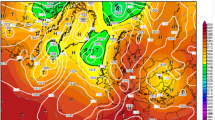Abstract
Described is the impact of the Aral Sea desiccation on the local climate and the impact of its numerical prediction in the region. Presented is the analysis of two series of numerical experiments with the WRF-ARW model (numerical prediction and weather research) with the spatial resolution of 5 km and 28 σ-surfaces along the vertical up to the level of 50 hPa for the Aral Sea region. In the first series of forecasts for January and July 2009, underlying surface parameters from the MODIS database are used. In these series the sea surface mask corresponds to the Aral Sea configuration in the 1970s. In another group of experiments, the characteristics of the underlying surface of the Aral Sea area are replaced by the respective characteristics of the surrounding land. To study the effects of variations of surface properties, air temperature, humidity, cloudiness, precipitation, and wind are analyzed. It is demonstrated that if the Aral Sea is assumed to be absent in the model, this results in the significant strengthening of the continentality of regional climate and in the increase in the forecast skill scores. The supposition is made that the regular (at least each 3–5 years) update of global databases with the description of underlying surface properties due to the climate change can result in the considerable increase in the accuracy of numerical prediction and climate change modeling.
Similar content being viewed by others
References
V. I. Bortnik and S. P. Chistyaeva, The Aral Sea. Hydrometeorology and Hydrochemistry of the USSR Seas, Vol. 7 (Gidrometeoizdat, Leningrad, 1990) [in Russian].
P. O. Zav’yalov et al., The South Aral Sea in the Early 21st Century: Physics, Biology, and Chemistry (Nauka, Moscow, 2012) [in Russian].
K. G. Rubinshtein, E. N. Egorova, and A. B. Shmakin, “Regional Changes in Hydrological Balance on the Land and in the Atmosphere as a Result of Deforestation in Siberia (Results of Numerical Experiments with GAC Model of Hydrometcenter of Russia),” in Proceedings of International Theoretical Conference “Issues of Hydrometeorology and Environment on the Threshold of the 21st Century” (Gidrometeoizdat, Leningrad, 2000) [in Russian].
O. I. Subbotina, S. G. Chernysheva, et al., Climate Variability in Central Asia, Ed. by F. A. Muminov and S. I. Inogamova (SANIGMI, Tashkent, 1995) [in Russian].
V. E. Chub, Climate Change and Its Impact on Nature-resource Potential of the Republic of Uzbekistan (Glavgidromet, Tashkent, 2000) [in Russian].
K. Bosch, L. Erdinger, F. Ingel, et al., “Evaluation of the Toxicological Properties of Ground- and Surface-Water Samples from the Aral Sea Basin,” Sci. Total. Environ., 374 (2007).
P. Bougeault and P. Lacarrere, “Parameterization of Orography-induced Turbulence in a Mesobeta-scale Model,” Mon. Wea. Rev., 117 (1989).
L. Gates and S. Lies, Impacts of Deforestation and Afforestation in the Mediterranean Region as Simulated by the MPI Atmospheric GCM (Max-Plank-Institut fur Meteorologie, Hamburg, 1999), Report No. 301.
Z. I. Janjic, Nonsingular Implementation of the Mellor-Yamada Level 2.5 Scheme in the NCEP Mesomodel, NCEP Office Note, No. 437 (2002).
J. S. Kain, “The Kain-Fritsch Convective Parameterization: An Update,” J. Appl. Meteorol., 43 (2004).
V. M. Khan, R. M. Vilfand, and P. O. Zavialov, “Long-term Variability of Air Temperature in the Aral Sea Region,” J. Marine Systems, 47 (2004).
J. Lean et al., “The Simulated Impact of Amazonian Deforestation on Climate Using Measured ABRACOS Vegetation Characteristics,” in Amazonian Deforestation and Climate (John Wiley and Sons, Chichester, UK, 1996).
P. Micklin, “Water in the Aral Sea Basin of Central Asia: Cause of Conflict or Cooperation,” Eurasian Geography and Economics, 43 (2002).
E. J. Mlawer, S. J. Taubman, P. D. Brown, et al., “Radiative Transfer for Inhomogeneous Atmosphere: RRTM, a Validated Correlated-k Model for the Longwave,” J. Geophys. Res., No. D14, 102 (1997).
J. Perera, “A Sea Turns to Dust,” New Sci., 23 (1993).
E. Roget, P. Zavialov, V. Khan, and M. A. Muniz, “Geodynamical Processes in the Channel Connecting the Two Lobes of the Large Aral Sea,” Hydrol. Earth Syst. Sci., 13 (2009).
W. C. Skamarock et al., A Description of the Advanced Research WRF Version 3, NCAR Tech., Note NCAR/TN-4751STR (2008).
E. E. Small, F. Giorgi, and D. Nychka, “Changes in Surface Air Temperature Caused by the Desiccation of the Aral Sea,” J. Climate, 14 (2001).
E. E. Small, F. Giorgi, L. C. Sloan, and S. Hostetler, “The Effects of Desiccation and Climatic Change on the Hydrology of the Aral Sea,” J. Climate, 14 (2001).
E. E. Small, L. C. Sloan, F. Giorgi, and S. Hostetler, “Simulating the Water Balance of the Aral Sea with a Coupled Regional Climatelake Model,” J. Geophys. Res., 104 (1996).
Author information
Authors and Affiliations
Corresponding author
Additional information
Original Russian Text © K.G. Rubinshtein, M.M. Smirnova, V.I. Bychkova, S.V. Emelina, R.Yu. Ignatov, V.M. Khan, V.A. Tishchenko, E. Roget, 2014, published in Meteorologiya i Gidrologiya, 2014, No. 11, pp. 24–35.
About this article
Cite this article
Rubinshtein, K.G., Smirnova, M.M., Bychkova, V.I. et al. Studying the impact of large lake desiccation on the accuracy of numerical description of meteorological fields (a case study for the Aral Sea). Russ. Meteorol. Hydrol. 39, 727–735 (2014). https://doi.org/10.3103/S1068373914110028
Received:
Published:
Issue Date:
DOI: https://doi.org/10.3103/S1068373914110028




